Introduction
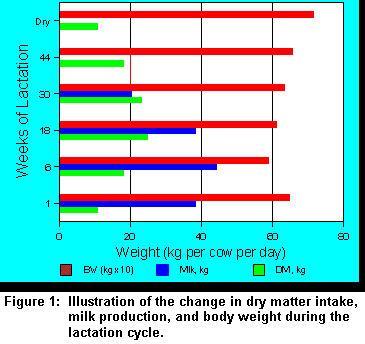 In 1983, R.E. Walton (as cited by Coppock,
1985; 3) projected that by the turn of the century individual cows would produce over 31,000 kg
of milk during a lactation with individual herds reaching records of 16,000 kg of milk. Since this
projection, three cows in North American have completed lactation records in excess of 26,800
kg. Individual herds have broken the 14,000 kg herd average limit. Cow records of this
magnitude require cows to average more than 90 kg of milk per day during peak lactation. To
achieve this level of production, dairy cows genetically capable of this level of milk production are
kept healthy in a well managed environment.
In 1983, R.E. Walton (as cited by Coppock,
1985; 3) projected that by the turn of the century individual cows would produce over 31,000 kg
of milk during a lactation with individual herds reaching records of 16,000 kg of milk. Since this
projection, three cows in North American have completed lactation records in excess of 26,800
kg. Individual herds have broken the 14,000 kg herd average limit. Cow records of this
magnitude require cows to average more than 90 kg of milk per day during peak lactation. To
achieve this level of production, dairy cows genetically capable of this level of milk production are
kept healthy in a well managed environment.
This extreme scenario helps illustrate the possible energy requirements placed on early postpartum cows. As illustrated in Figure 1, there is a delay in dry matter and energy intake. Milk energy secreted exceeds energy intake during early lactation resulting in a negative energy balance. Lactating dairy cows mobilize stored body fat to "balance" this energy deficit. Andrew and co-workers (1) illustrated this change by measuring body composition of dairy cows during early lactation, late lactation, and dry period (Table 1). As these results indicate, the early postpartum cow depends on stored body fat for energy until feed intake supports a positive energy balance. During positive energy balance of the mid and late lactation periods, the animal replenishes body fat. Notice, however, that live body weight was not different between cows of different stages of lactation.
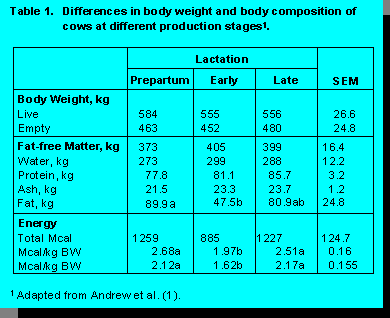 This difference between live weight and fat content was a primary reason that a system for body
condition scoring (BCS) of dairy cattle was developed. As Edmonson and others report, BCS was
first developed for use in sheep. This subjective technique of assessing subcutaneous fat storage
has been adapted for beef and dairy cattle with variations of the system by country. The most
widely utilized BCS system in North America is that reported by Wildman and co-workers at
Virginia Tech (14). These production and veterinary scientists used 30 commercial dairy herds in
Virginia to develop the 1 to 5 system. In this system, a score of 1 represents severe
undercondition (anorexic) with a score of 5 being extremely over conditioned (fat). This system
requires the BCS evaluator to palpate the vertebral column along the chine, loin, and rump;
processes of the loin; tailhead, hook, and pin bones. In Table 2, a brief description of each region
by score is given. As with every system, as others adapt and apply a new procedure, modifications
and improvements are made and incorporated.
This difference between live weight and fat content was a primary reason that a system for body
condition scoring (BCS) of dairy cattle was developed. As Edmonson and others report, BCS was
first developed for use in sheep. This subjective technique of assessing subcutaneous fat storage
has been adapted for beef and dairy cattle with variations of the system by country. The most
widely utilized BCS system in North America is that reported by Wildman and co-workers at
Virginia Tech (14). These production and veterinary scientists used 30 commercial dairy herds in
Virginia to develop the 1 to 5 system. In this system, a score of 1 represents severe
undercondition (anorexic) with a score of 5 being extremely over conditioned (fat). This system
requires the BCS evaluator to palpate the vertebral column along the chine, loin, and rump;
processes of the loin; tailhead, hook, and pin bones. In Table 2, a brief description of each region
by score is given. As with every system, as others adapt and apply a new procedure, modifications
and improvements are made and incorporated.
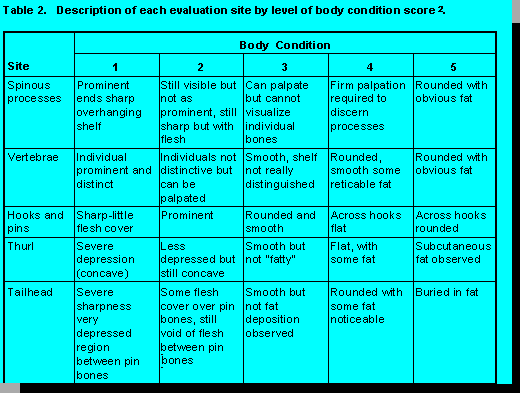
The subjective nature of the measurement required that the system be validated. Edmonson et al. (6) introduced a chart in 1989 to help the assessor in evaluating the score (Figure 2). In this study, researchers reported the area from the hips back to and including the tailhead region was an effective indicator of overall BCS. Ferguson and colleagues (7) verified the ability of evaluators to assess BCS. This group reported that between BCS 2.5 to 4.0, units of .25 could be used with .5 units used in cases outside this range. For all scores, evaluators matched the mode exactly 58.1% and deviated by .25 units 32.6% of the time.
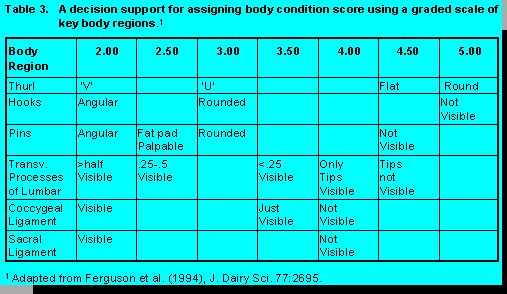
Based on the statistical modeling, Ferguson et al. (7) developed a decision chart for BCS using the principal body regions evaluated (Table 3). Domecq and others (4, 5) used ultrasound to validate body condition scores and subcutaneous fat cover. One other question often raised deals with frequency of observation. Hady et al. (9) reported that BCS intervals of 30 days allowed for precise measurement of BCS and more importantly the change in BCS over time could be described. Therefore, trained BCS evaluators can accurately assess the level and change of subcutaneous body stores as an indicator of energy balance.
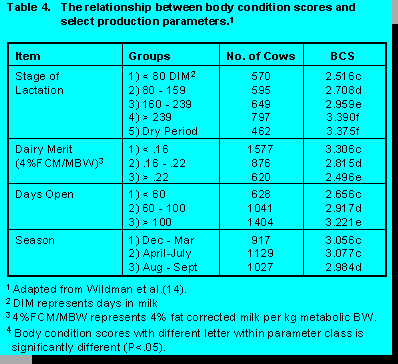 Wildman et al. (14) reported cows in early
lactation had lower BCS than late lactation cows
(Table 4). They also reported higher producing cows had lower BCS. These results show
monitoring BCS can be used as a part of the farm management decision support database.
However, with the refinement of the technique, farm managers, consultants, and herd health
veterinarians need established targets or goals for stages of the production cycle. In other words,
what is the "ideal" body condition score of a cow at strategic points during the lactation. Body
condition score and changes in BCS of a herd are dynamic. In order to discuss BCS, losses, and
gains, we will begin in late lactation. Body weight gain and subsequent conversion to milk is
more efficient when the cow gains body weight during lactation. Moe et al. (10) reported a
lactating cow is 15% more efficient in conversion of feed energy to tissue energy compared to a
dry cow. Lost body reserves are best replaced during late lactation. Therefore, the
management goal is to have cows begin the dry period in the ideal body condition. This allows
the dry period to focus on managing of the dry cow to maintain condition, mammary gland
involution and healing, and optimal fetal growth. The question is still -- what is the optimal Body
Condition Score for a cow at calving?
Wildman et al. (14) reported cows in early
lactation had lower BCS than late lactation cows
(Table 4). They also reported higher producing cows had lower BCS. These results show
monitoring BCS can be used as a part of the farm management decision support database.
However, with the refinement of the technique, farm managers, consultants, and herd health
veterinarians need established targets or goals for stages of the production cycle. In other words,
what is the "ideal" body condition score of a cow at strategic points during the lactation. Body
condition score and changes in BCS of a herd are dynamic. In order to discuss BCS, losses, and
gains, we will begin in late lactation. Body weight gain and subsequent conversion to milk is
more efficient when the cow gains body weight during lactation. Moe et al. (10) reported a
lactating cow is 15% more efficient in conversion of feed energy to tissue energy compared to a
dry cow. Lost body reserves are best replaced during late lactation. Therefore, the
management goal is to have cows begin the dry period in the ideal body condition. This allows
the dry period to focus on managing of the dry cow to maintain condition, mammary gland
involution and healing, and optimal fetal growth. The question is still -- what is the optimal Body
Condition Score for a cow at calving?
Theoretically, the ideal BCS will support peak milk production during the negative energy balance of the transition period. The ideal BCS will not disrupt normal metabolism or result in metabolic disorders. The question of ideal body condition does not warrant a theoretical hypothesis, but instead a practical answer.
A growing number of studies have been designed to evaluate BCS at calving and BCS change on the subsequent milk yield, fertility, and health of the animal. Biosclair et al. (2) reported no difference in milk yield during the first 120 days after calving in cows fed high energy diets during the dry period. Cows fed the high energy diets had a higher BCS at calving (3.38 for 100% energy requirement versus 3.73 or 3.99 for 131% or 162% energy requirement, respectively). In a second study, cows with higher BCS at calving due to high energy feeding during late lactation or the dry period had from 2 to 3 kg more milk per day during the first 120 days of lactation. These results agree with those from researchers at Michigan State who reported cows that gained body condition during the dry period produced more milk. In the analysis reported by the Michigan State group, an increase of one-point between the initiation of the dry period and calving corresponded to 545 kg more milk in the first 120 days of lactation. It is important to point out that the Michigan State study involved cows from one commercial herd with an average BCS at dry-off of 2.77 for mature cows. Therefore, based on several guidelines, the high producing cows used in the Michigan State study required additional body condition before calving.
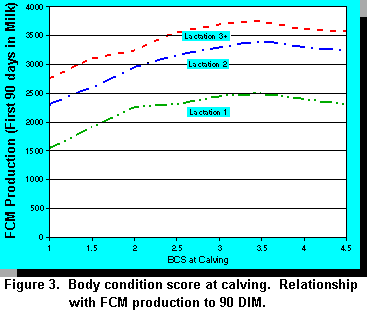 In 1993, Pedron et al. (11) reported that the
BCS at calving did not affect milk production (Table
4). However, the pattern or extent of body condition loss after calving was related to increased
milk production. A net decrease of 1 unit BCS corresponded to an increase of 438 kg in mature
equivalent (ME) milk production and 422 kg of 305-d milk production. These results point out
the
importance of having adequate body condition available to support peak milk yield. Waltner and
co-workers (13) at Washington State University further investigated the relationships between
BCS and milk production of Holsteins. This report suggested a quadratic response relationship
existed between BCS at calving and FCM production during the first 90 days (Figure 3).
Furthermore, these workers reported a curvilinear response to change in BCS and 305-D fat
corrected milk (FCM; Figure 4). These results suggest an optimal BCS at calving would be
between 3 to 4. They also indicate a goal would be to have a change in body condition of .5 to 1.0
from calving to 120 days in milk.
In 1993, Pedron et al. (11) reported that the
BCS at calving did not affect milk production (Table
4). However, the pattern or extent of body condition loss after calving was related to increased
milk production. A net decrease of 1 unit BCS corresponded to an increase of 438 kg in mature
equivalent (ME) milk production and 422 kg of 305-d milk production. These results point out
the
importance of having adequate body condition available to support peak milk yield. Waltner and
co-workers (13) at Washington State University further investigated the relationships between
BCS and milk production of Holsteins. This report suggested a quadratic response relationship
existed between BCS at calving and FCM production during the first 90 days (Figure 3).
Furthermore, these workers reported a curvilinear response to change in BCS and 305-D fat
corrected milk (FCM; Figure 4). These results suggest an optimal BCS at calving would be
between 3 to 4. They also indicate a goal would be to have a change in body condition of .5 to 1.0
from calving to 120 days in milk.
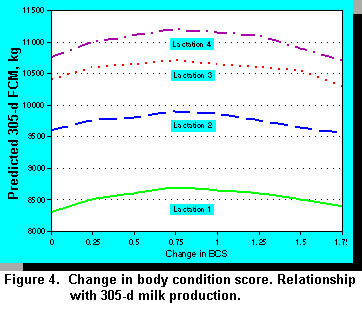 Body condition score and changes in body
condition influence animal health and reproductive
performance. Gearhart et al. (8) found over-conditioned cows at calving had increased risk of
developing reproductive and lameness problems. Thin cows at dry-off had increased risk of
lameness. This relationship may be associated with increased energy (grain) supplementation to
thin cows during the dry period that may predispose cows to feet problems. Ruegg and Milton
(12) reported a study conducted on Holstein cows on Prince Edward Island. In contrast to the
previous workers, these investigators did not report an association between BCS or periparturient
disease. Excess body condition does predispose cows to metabolic disorder as discussed in a
paper by Dr. Grummer in these proceedings. Excellent management can minimize the potential
adverse effects of excessive body weight.
Body condition score and changes in body
condition influence animal health and reproductive
performance. Gearhart et al. (8) found over-conditioned cows at calving had increased risk of
developing reproductive and lameness problems. Thin cows at dry-off had increased risk of
lameness. This relationship may be associated with increased energy (grain) supplementation to
thin cows during the dry period that may predispose cows to feet problems. Ruegg and Milton
(12) reported a study conducted on Holstein cows on Prince Edward Island. In contrast to the
previous workers, these investigators did not report an association between BCS or periparturient
disease. Excess body condition does predispose cows to metabolic disorder as discussed in a
paper by Dr. Grummer in these proceedings. Excellent management can minimize the potential
adverse effects of excessive body weight.
Summary and Conclusions
The differences in response to calving BCS and early lactation change in BCS suggest an interaction exists with level of management, especially during the transition period from late lactation to early lactation of the subsequent lactation. Optimal body condition at calving based on summarized research reports would be 3.0 to 3.5. During early lactation, a controlled loss of body condition of .5 to 1.0 units is associated with optimal peak milk production, health, and reproductive performance. Excessive BCS losses at calving predisposes the animal to metabolic disorders as discussed by another presenter at this conference. However, inadequate body condition could limit energy available to drive milk production during the negative energy balance of the early lactation period. An anonymous author has pointed out that "If you don't measure it, you can't manage (it)". Body condition scoring, while a subjective estimate, can be used effectively to monitor changes in energy balance. Body condition scores are best evaluated at dry off, calving, 30, 60, and 90 days in milk; then 150 days in milk, and 200 days in milk. Closely monitoring BCS should be an integral part of the production management information used by the dairy farm management team.